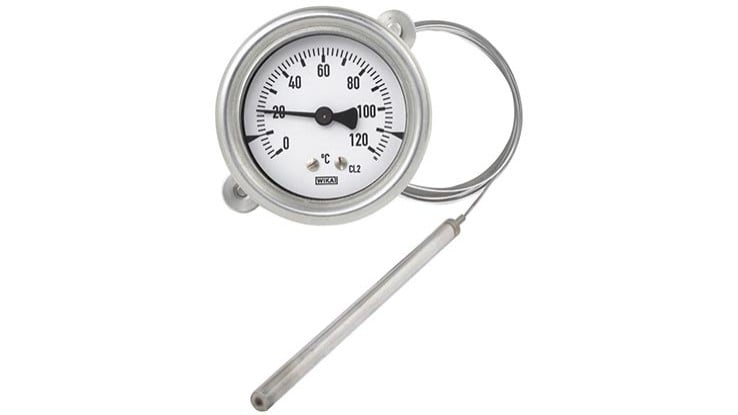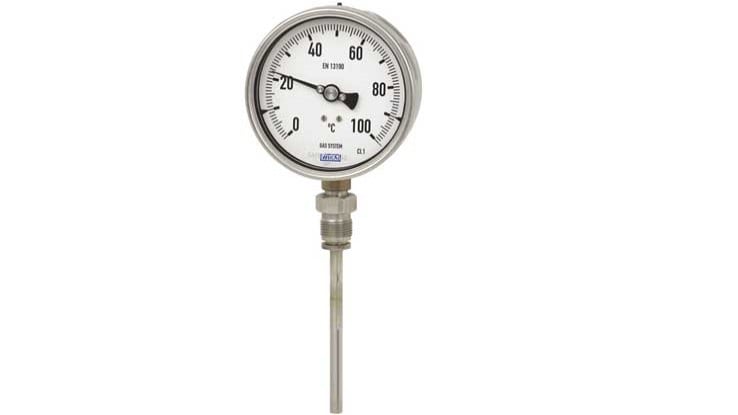Temperature measuring instruments by WIKA
Different methods are used to measure and monitor temperature in industrial applications. The measuring ranges and measured values also play a large part in the selection of the right temperature measuring instrument. Whether you are looking for a bimetal temperature gauge,gas-actuated temperature gauge or expansion temperature gauge, WIKA helps you find the right temperature gauge for your application.
WIKA offers a wide portfolio of temperature gauges:
What temperature gauges does WIKA offer?
For temperature measurement and temperature monitoring, different measurement procedures can be used. WIKA offers professional temperature measuring instruments using the gas-actuation, bimetal or expansion principle. They can measure measured values between -200 … +700 °C (-328 ... +1,292 °F). All instruments are also suitable for operation in thermowells. In industrial temperature measurement, primarily two types of dial thermometers are used: bimetal and gas-actuated thermometers. Which measurement principle should be used depends on a number of different factors, such as response time, temperature limits & application range. You can learn more about the differences in our video "Bimetal vs. gas-actuated thermometers | What's the difference?"..
What is a temperature gauge?
Temperature gauges measure the thermal state of a homogeneous substance. The measuring system must be brought as closely together as possible with the body to be measured. The most widely used measuring methods for temperature measurement rely on temperature-dependent characteristics of the body and substance.
How does a bimetal temperature gauge work?
Bimetal temperature gauges operate with a measuring system in the form of a helical or spiral tube. The measuring system consists of two sheets with different expansion coefficients, which are inseparably joined. Through the mechanical deformation of the bimetal strips in the aforementioned tube types, a rotational movement results, caused by temperature changes. If one end of the bimetal measuring system is firmly clamped, the other end will rotate the pointer shaft. Bimetal temperature gauges are available with a measuring range of -70 ... +600 °C (-94 ... +1,112 °F) in accuracy classes 1 and 2 in accordance with EN 13190.
When is an expansion temperature gauge suitable?
An expansion temperature gauge consists of a temperature probe, a capillary and a Bourdon tube, and is also suitable for temperature measurement at remote measuring locations. The measuring system itself is filled with a liquid. If the temperature changes, the internal pressure of the temperature gauge with probe will change as well. The pressure is transferred via a tube to a pointer shaft and thus the temperature value is indicated on the scale. Using remote capillaries from 500 ... 10,000 mm long, measurements can also be taken from remote measuring locations. The measuring ranges for expansion temperature gauges lie between -40 ... +400 °C with class 1 and 2 accuracies in accordance with EN 13190.
How does a temperature gauge using the gas-actuation principle work?
With a gas-actuated temperature gauge the stem, the capillary and the Bourdon tube are joined together into one unit. The instrument is filled with inert gas. If the temperature changes, the internal pressure will also change. The pointer is moved by the action of the pressure via a measuring tube. To compensate for the ambient temperature, a bimetal element is mounted between the movement and the measuring tube. Gas-actuated temperature gauges are available with scale ranges between -200 ... +700 °C (-328 ... +1,292 °F) in accuracy class 1.
When is a machine-glass temperature gauge used?
Machine-glass temperature gauges are suitable for temperature monitoring in gases, vapours and liquids in vessels and pipelines. The thermometer is housed in a case with a cutout for the scale display. Machine glass thermometers are often used with a V-shaped case.

Why is the bending on temperature rises not linear over the entire temperature range?
Since the specific thermal expansion coefficient of the bimetallic components is temperature dependent.








